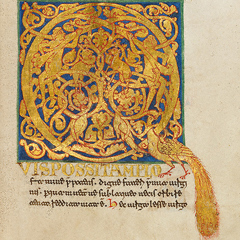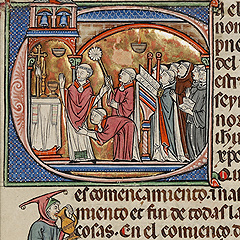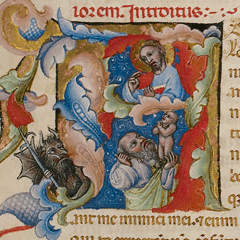|
Just outside the blocks of Latin text and larger illustrations, the pages of medieval books often teem with tiny characters, creatures, and fantastic plants—collectively called "marginalia."
|
 |
|
|
 |
|
Scenes in the margins of a page often comment on the paintings illustrating the text in the center. As often as they expand on the narrative, they also poke fun at the lofty themes and, more broadly, at human foibles.
This exhibition covers the sweep of marginalia's history in three stages of development: beginning in the early Middle Ages with Ottonian and Romanesque art, reaching its zenith with Gothic illumination, and working its way into the borders of late medieval manuscripts.
|
 |
|
Artists of the Ottonian dynasty, between 920 and 1020, enlivened initial letters with whimsical figures. During the Romanesque period, about 1050 to 1200, intertwined figures and plant forms created rhythmic compositions, as you can see in the inhabited Q (at right).
The delightful treatment of vines, as if they were real plants with a three-dimensional presence, influenced the design of late medieval borders. Later illustrators would free them from the initials to embellish the margins of pages.
|
 |
|
Gothic illumination, which flourished in northern Europe from about 1200 to 1350, is distinguished by an interest in naturalism. Artists expressed the full range of human interaction through animated gestures and poses.
In some cases, marginal scenes simply expanded or supplemented a topic introduced by the page's text or illustration. In other cases, the relationship is less obvious. Secular subjects in the margins of religious books set a precedent for scenes of everyday life.
|
 |
|
Illuminators of the 1400s and 1500s used many of the marginal motifs known from earlier manuscripts. They differed, however, by integrating marginalia into elaborate borders strewn with naturalistic foliage and abstract patterns, such as the ornate example (at right).
Painting in late medieval and Renaissance manuscripts demonstrates artists' interest in capturing visual experience and representations of the natural world. Manuscript illustrators increasingly emphasized the interrelatedness of primary and marginal scenes, adding narrative complexity.
|
 |



